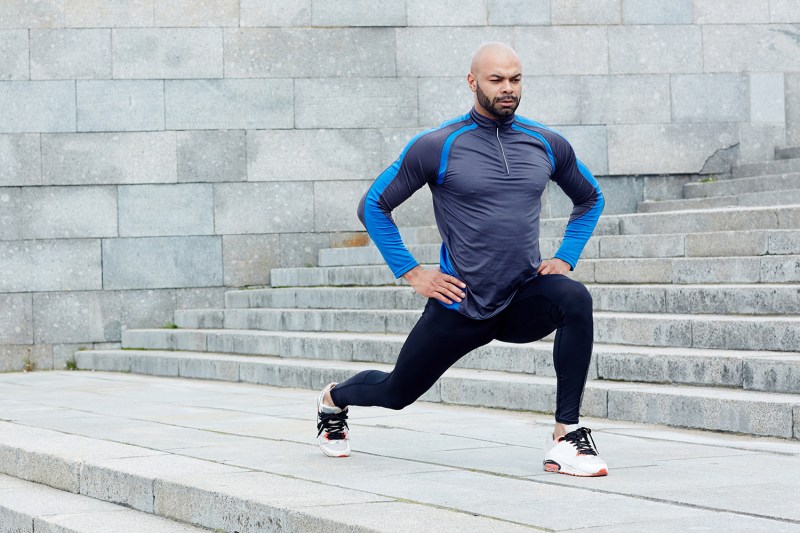Walking lunges are a killer move to add to leg day. You’ll power up those quads and major leg muscles while also working on your balance as you ‘walk’ forward in the lunge position. The original lunge will always be among the elite exercises for legs and balance, but there are also several worthwhile variations to switch it up, including walking lunges. Read on for your complete guide to walking lunges.
What are walking lunges?

Walking lunges are a variation of the original lunge where you ‘walk’ forward by lunging with the other leg instead of just standing up straight again. The lunge is a static effective bodyweight exercise, whereas the walking lunge gets you moving and really helps you perfect your lunge technique.
Why are walking lunges more challenging?

Walking lunges are more challenging because you have to keep your balance while standing on one leg and shifting your weight and your whole body positioning forward to your other leg. You might need to start by mastering the original lunge before working your way up to performing the walking lunge. Adding dumbbells heightens the challenge.
What are the benefits of walking lunges?

Walking lunges are a worthwhile lower-body strength training exercise that provides numerous benefits, including:
- Combining strength training with cardiovascular fitness.
- Engage multiple muscle groups, including quads, hamstrings, glutes, and core.
- Enhance your lower body strength, hip flexibility, and agility.
- Enhance your overall stability, balance, and functional fitness.
- Better balance and stability mean a lower risk of falls and injuries.
- Ramp up your heart rate when you perform walking lunges for high reps or time.
- Research shows the lunge body position increases the stability of the core muscles.
- Train unilaterally, which can help address muscular imbalances.
- It’s a versatile move you can perform pretty much anywhere.
Compound or multi-joint exercises like lunges target three key areas of fitness: strength, cardiovascular, and flexibility.
What muscles are targeted during walking lunges?

You’ll activate the following muscles when you perform walking lunges:
- Glutes
- Hips
- Abdominals and core
- Hamstrings
- Quads
- Calves
You’ll work all major muscles in your lower body.
How to do walking lunges

Make sure you have enough room to take wide strides.
Here’s how to do walking lunges:
- Stand with your torso upright and your feet about shoulder-width apart.
- Engage your core and keep your gaze straight ahead.
- You can place your hands on your hips or let your arms hang down by your sides.
- Step forward with your right foot so it’s about two feet in front of you.
- Plant your right foot firmly on the ground in front of you and allow your left heel to lift up naturally as you bend both knees.
- Lower your back knee down until it almost touches the ground in the lowest part of the lunge position.
- Press firmly down through your right heel and start straightening your legs to bring yourself back to stand while also swinging your left leg forward about two feet in front of you.
- Now, you can perform the lunge on the other side.
- With each lunge, continue alternating sides and stepping forward.
- When you’re ready to stop, make sure you’re balanced, and bring your back foot next to your front to stand up.
Top tips for proper technique

Master your technique and optimize your results with these top tips:
- Try to maintain an upright torso.
- Engage your core.
- Start by mastering the regular lunge before attempting the walking lunge.
- Start with a shorter stride until you improve your balance.
- Work on other similar balance moves like Bulgarian split squats.
- Your legs should be at 90-degree angles when your knees are fully bent in the lunge position.
- Try to make sure your front knee is in line with your toes.
You should stop the exercise immediately if you experience sudden and sharp pain. Consult with your physical therapist, personal trainer, or healthcare provider if you’re not sure if you should perform walking lunges.
Common mistakes to avoid

The following are the most common mistakes to avoid when performing walking lunges:
- Leaning too far forward or backward.
- Leading with your shoulders.
- Caving your knees in and out.
- Placing your front leg too far out in front of you and losing stability.
- Stepping with your feet too close together and in line with each other rather than shoulder-width apart, which compromises your balance.
Variations

Here are some of the most common walking lunge variations to try:
- Overhead walking lunge — Holding a weight above your head increases the difficulty.
- Dumbbell walking lunge — Holding two dumbbells or weights down at your sides helps you build strength.
- Walking lunges with torso twist — Holding a medicine ball or weight at your center and twisting your torso fine-tunes your spinal rotation and targets your obliques and core.
How to include walking lunges in your routine

You can include walking lunges in your workout schedule two or three times a week to develop strength and




